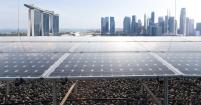

Building the Next Phase of Growth in Southeast Asia Around Renewable Energy. It’s Possible.
Newsletter
It is one of the fastest growing and dynamic regions in the world. A global trade hub and a strong example of the benefits of regional cooperation, Southeast Asia promises to emerge as one the most successful economic development stories of the 21st century. To fulfill its full potential however, the region should turn decisively to renewables to meet rising energy demand.
IRENA Director-General Francesco La Camera will reinforce the importance of a low-carbon energy path in Southeast Asia at the Singapore International Energy Week 2019 (SIEW) this week. With energy consumption expected to double by 2040 meeting rising demands with secure, affordable and clean supply may be one of the most important priorities the countries of the Association of Southeast Asian Nations (ASEAN), face today.
In a keynote address at SIEW IRENA Director-General Francesco La Camera will outline a pathway to prosperity bolstered by low-carbon technologies. With the event taking place under the theme of “Accelerating Energy Transformation” the Director General’s opening keynote highlighted that renewables are the only way to meet rising demand whilst reducing emissions, noting that the transformation can be done cost-effectively and with significant benefits to ASEAN.
The Director-General will point to recent auctions in the region that have seen bids below the cost of generating power from gas and that would, until just a few days ago, have made global records. Noting global trends that have seen renewables move from what was once a luxury just a decade ago, to now being seen as the lowest-cost source of new power generation in a growing number of contexts. IRENA believes renewables will compete with any fossil fuel in Southeast Asia by 2025.
In an op-ed published ahead of SIEW Mr. La Camera addressed the notion of cheap coal. He said that powering growth with fossil fuels – particularly coal – is unlikely to be the least cost option if externalities such as health and the consequences of climate change are factored in to economic projections. This is against a backdrop of the Asian Development Bank’s forecast that Southeast Asia’s GDP could shrink by 11 per cent by the end of the century due to climate change. In this context, the Director-General points out, coal is almost certainly not the least expensive power generation option.
Beyond the Director-General’s keynote speeches a new IRENA report on the decarbonisation of shipping will be presented at the Global Maritime Forum. The report, entitled: “Navigating the way to a renewable future: Solutions to decarbonise shipping", explores the impact of maritime shipping on CO2 emissions, characterises the shipping sector and identifies various clean energy solutions with the potential to reduce the sector’s carbon footprint. International shipping represents around 9 per cent of the global emissions associated with the transport sector, thus making the reduction of maritime emissions key to achieving climate goals.
To the ministers, business leaders and leading industry officials of Southeast Asia, the Agency’s message is that it’s possible to accelerate the speed of transformation and to meet climate and sustainable development goals, with renewables. Long-term policy decisions and a significant increase in investment flows should align with the region’s stated goal to scale up the share of renewables in primary energy to 23 per cent of by 2025. In its going commitment to ASEAN energy transformation, IRENA stands ready to support.




